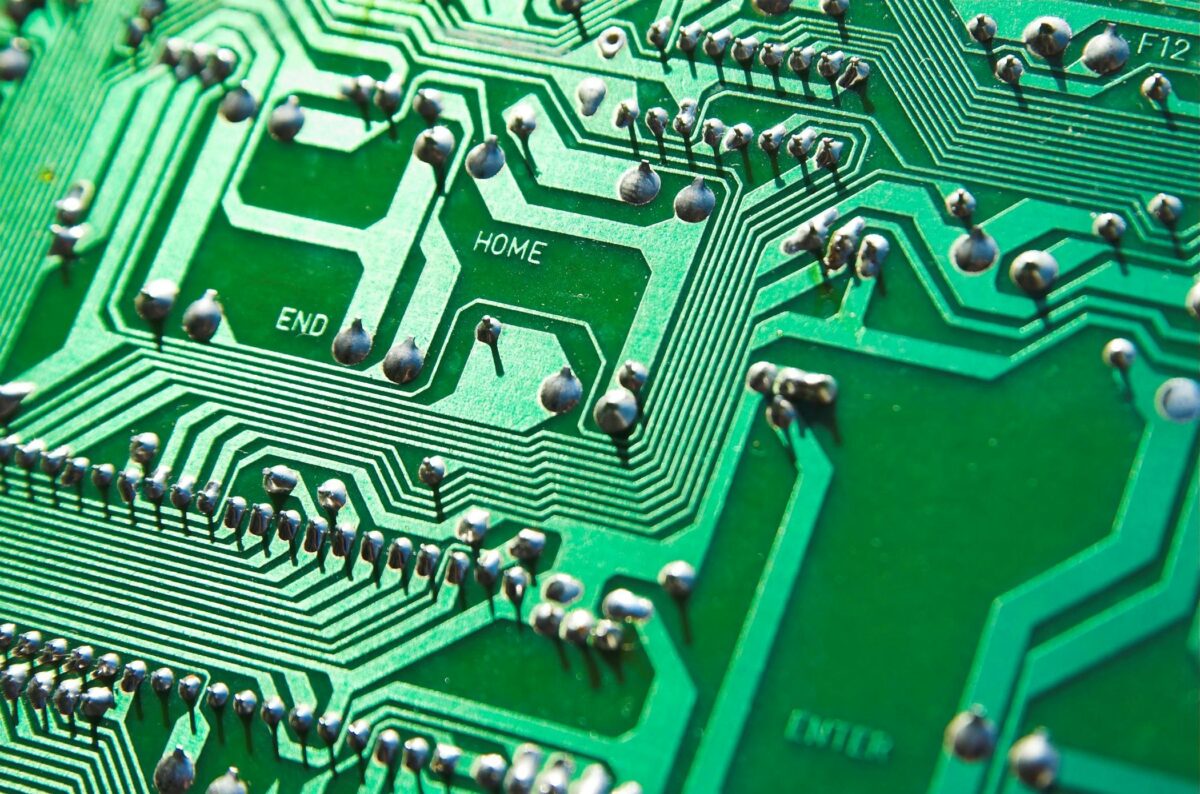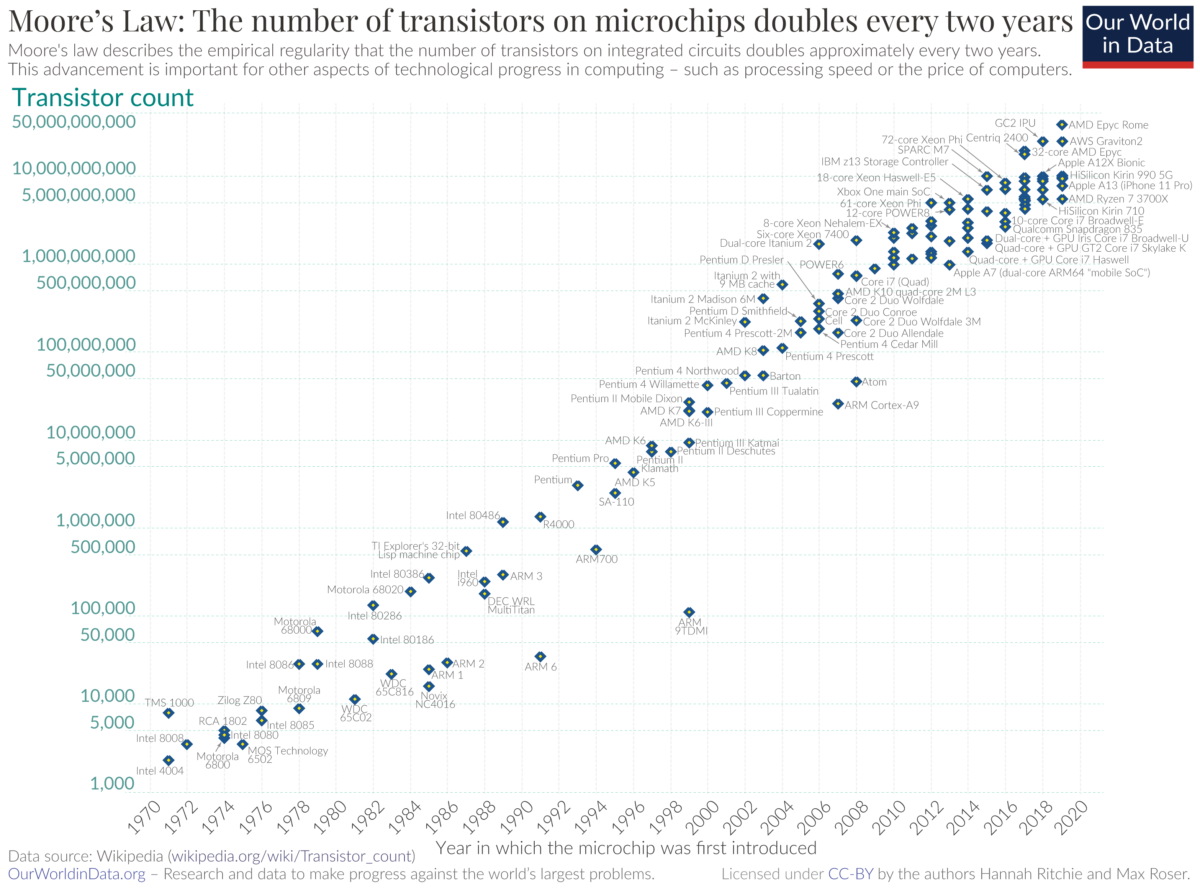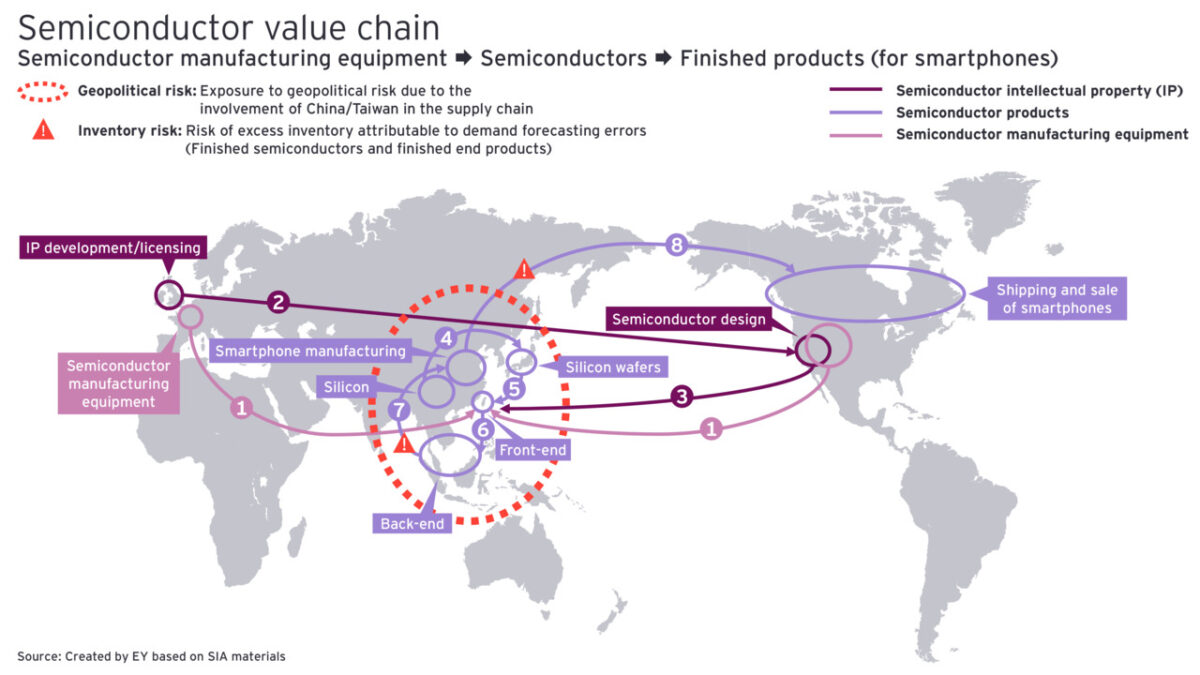Technology has an undeniable effect on our lives. Everyday, we use it, sometimes without putting much thought into it. Technology is defined as the application of scientific knowledge for practical uses. From stones creating fire to Large Language Models like ChatGPT answering questions, technology has played a fundamental role in our existence as humanity. Light bulbs, the printing press, cars, airplanes, computers, and wifi, to cite a few impactful examples, have all revolutionised the way we live.
I have had the chance of asking Michele D’Urbino, microelectronics engineer, about the tiny little chips used in computers and smartphones. The tech industry has been booming with recent advances in artificial intelligence and quantum mechanics and, as a result, the demand for microelectronics has too. You probably have heard of the company Nvidia rising as the world’s third most-valuable company in early 2024, with skyrocketing sales of compute and networking. At the same time, microchips have created new risks and tensions on a global scale. Some states fear supply chain disruptions that would dramatically impact our societies, given how dependent we have become of the tiny machines.
In this interview, we dive deep inside the world of technology and uncover how microchips work, why geopolitical tensions arose around their manufacturing, why the semiconductors industry has been booming, as well as upcoming trends in the microelectronics industry.
About Michele D'Urbino, Design Engineer at SiTime Corporation
Sophie: Hi Michele! Could you introduce yourself and tell us a little bit about what you do?
Michele: I’m Michele D’Urbino, I did my Bachelor’s degree in biomedical engineering at Politecnico di Milano, and continued my education with a Master’s in microelectronics in Delft, the Netherlands. I also hold an MBA from the Quantic School of Business and Technology. I have worked briefly in Belgium in the field of imaging sensors (cameras) for scientific and space applications. Now, I work as a design engineer for the Dutch office of a Silicon Valley-based corporation (SiTime) that develops micro-electromechanical systems (MEMS), commonly known as microchips.

My main field of specialization is analog electronics: basically a bridge between the world of physics and nature, and the digital world. It answers questions like: how can I make a computer understand the physical quantities that humans perceive (light, temperature, color, sound) but also phenomena that we cannot sense ourselves, like radio waves, magnetic fields, chemical traces…
In practical terms, this translates into designing integrated circuits, or chips. These small spider-like silicon pieces, despite their minuscule size, embody an incredible level of complexity. Chips are the main building blocks for all modern electronics, and can serve many different purposes (sensing, computing, storing data, transmitting and receiving, driving motors…). Fabricating such tiny marvels is also extremely challenging: for this purpose, the Dutch company ASML has created the most complex machine ever known to men.
For the last 6 years, I have been working in the field of timing. Timing and synchronization are critical parts of any system: think of it as the heartbeat of electronics. I think of it as the natural evolution of clockmaking, translated to the 21st century. The challenges are very similar: extreme precision and complexity should be achieved, while the size and energy usage should be minimized. We are able tocreate chips that have a precision of one-billionth of a second, while others can operate for years on a small coin-like battery.
Microelectronics applications in our daily lives
S: Wow! That sounds super cool. I can imagine that a lot of the machines we use everyday rely on this type of technology, is that correct? What kind of “everyday objects” use microchips? Which types of applications do you specialise in? What types of applications could you imagine coming up in the near future (~3 years)?
M: It is easier to think about what doesn’t rely on microchips than to think of what does. In other words, most of the tools we use daily depend on microchips. Some of the most common objects that rely on chips are phones, laptops, watches, cars and so forth. It’s good to remember that virtually any branch of human knowledge has been transformed by electronics, and therefore today’s world cannot be imagined without them. Every software needs a hardware to run it, therefore everything from AI to weather forecast to apps on our phones ultimately are run by chips. Our economy relies on extremely fast chips making transactions. Our politics relies on chips recording, storing and broadcasting our leaders’ messages. It’s impossible to overstate the prevalence of chips today: everything that’s smarter than an ON/OFF switch is handled by chips (yes, even your bike’s blinking lights!).
I am very excited about brain-computer interfaces: while sci-fi scenarios like mind-reading machines are very far away, my hope is that in the next 3 years we will see the first practical uses, for example help patients affected by paralysis to re-gain control over their bodies.
As an engineer, the good thing of working on electronics is that the product you design can be used in an infinite number of ways. Some chips are extremely specialized for a specific application, we call those ASIC. But most of the chips I design can be used anywhere: cars, factories, phones… The basic principles behind designing a chip are mostly the same, regardless of the application, in fact many engineers don’t even know what their products are used for!
For the near future, the industry is focusing mostly on a handful of applications that offer significant technical challenges: automotive (self-driving cars), AI, quantum computing, internet of things (IoT) and networking (5G). Personally, I am very excited about brain-computer interfaces: while sci-fi scenarios like mind-reading machines are very far away, my hope is that in the next 3 years we will see the first practical uses, for example help patients affected by paralysis to re-gain control over their bodies.

Microchips, electronics, and semiconductors... What's the difference?
S: We often hear about chips together with microelectronics and semiconductors. What are those? What are the main components of chips? How would you explain their functioning simply?
M: I know, that can be very confusing! What came first was electricity, the ancient Greek word for amber. They were already aware of it! When electrons were discovered in 1897, people naturally started playing with them, that’s when electronics was born. At that time, getting anything useful out of those electrons (for example, resolving a basic math equation) took entire rooms full of huge machines. That all changed when it was discovered that certain materials, semiconductors, had the potential to shrink those huge machines to much more manageable sizes. The king of semiconductors has always been silicon, a very common element that can be found in sand and rocks of all kinds. Since then, it has been a journey towards miniaturization, that’s why we talk about microelectronics. Chips are nothing more than “engineered” squares of silicon, which can be processed to form billions of interconnected transistors.
Information is thought of as the single, most valuable resource one can possess, and without the hardware to support it, we would all be a whole lot poorer.
Now let me tell you about transitors. They are the most fundamental element in any type of electronic circuit. A bunch of transistors can be arranged together to perform complex math functions (logic), to store information (memory), or to transmit/receive it. In its essence, you can think of a transistor as a switch, for example, that on a table lamp wire. This switch decides whether the electric current will pass from one side to the other (light turns on) or not. Now, what is great about a transistor is that it doesn’t require your finger on the switch to decide what to do with the current: that can be controlled by another electric signal, for example the output of another transistor! Effectively, it acts like a tiny, smart traffic cop for electricity. you can combine many transistors to create complex patterns.
Microelectronics as a source of geopolitical power struggles
S: Those terms also often appear in the news at the moment, because it seems that only a few countries (the United States and Taiwan, for example) can produce them at large scale. This creates some rivalry, supply chain risks, and trade wars (for example by increasing import/export tariffs). Can you tell us a little bit about your perception of the industry in The Netherlands and/or in Europe and/or the world? In your view, how could chips be understood as “sources of power”?
M: There are many electronics companies that everyone has heard of: Nvidia, Apple, Qualcomm… But most companies, including the one I work for, only design chips, they don’t have the capabilities to produce them. The reason is that the factories (“fabs”) needed to manufacture chips can cost several billion USD, which isn’t spare change even for the aforementioned giants. TSMC is a Taiwanese company that produces more than 60% of the world’s chips, including those designed and used by the western companies I mentioned. The semiconductor market makes up one fourth of Taiwan’s entire GDP.
It’s been wildly proven that collaboration always benefits countries more than working in isolation. Unfortunately, in today’s world, I don’t see that happening anytime soon. The trend is going towards each country having to invest tens of billions to ensure their technologic survival, rather than rely on international trading.
So, what is China eyeing? Taiwan, or TSMC? China controlling or destroying TSMC would make the 2008 crisis look like a walk in the park. That’s why a lot of western companies try to ensure that they have alternative sources, in case something like this happens. Information is thought of as the single, most valuable resource one can possess, and without the hardware to support it, we’d all be a whole lot poorer. On the flip side, some of the key machines used by TSMC and other fabs are made by Europe and the US and are now subject to embargo measures towards China.
In an ideal world, we’d all benefit from each country’s strengths and strategic resources. It’s been wildly proven that collaboration always benefits countries more than working in isolation. Unfortunately, in today’s world, I don’t see that happening anytime soon. The trend is going towards each country investing tens of billions to ensure their national technologic survival, rather than rely on international trading. Needless to say, this doesn’t benefit anybody, and as an engineer, it saddens me to see the world converging to a non-optimal solution.
The boundaries of technological precision and complexity
S: You mentioned earlier that your job requires making extremely precise and complex little machines, like super powerful clocks. Do you see any potential end to that precision and complexity, in other words, do you think we can make chips infinitely more precise and complex? Or is there a physical limit to what is possible? What does that imply, practically?
M: Gordon Moore, co-founder of Intel, famously predicted that the number of transistors (see above) in a chip would double every two years. This means we can squeeze more functions in a smaller space. This goes by the name of “Moore’s law”, although it’s more of an observation or a wish than an actual law. This hunch turned out to be correct until recently. It’s what we witnessed from the 60’s to a few years ago: you bought a new computer or phone while fully aware that in 3 years’ time, it’d be nothing more than a useless carcass compared to the brand-new gadgets that would come out. However, that trend was doomed to meet a hard barrier: the size of atoms! Some companies today are able to produce transistors as small as 2-3 nanometers, or billionths of a meter. Well, that’s just a handful of atoms!
Now is the chance for young scientists to find a new path forward, to continue progressing. This may come in many forms, for example in the shape of quantum computing, which has the potential to revolutionize our field.
Moore’s law as we know it has slowed down in recent years, and eventually will stop. So now is the chance for young scientists to find a new path forward, to continue progressing. This may come in many forms, for example in the shape of quantum computing, which has the potential to revolutionize our field. Others bet on new materials (e.g. carbon nanotubes) or novel ways of combining existing components (e.g. neuromorphic computing).
One thing is for sure, while the past focused on blind miniaturization, the future will require creativity and courage. For this reason, it’s a unique and exciting time to approach the field of microelectronics.
Common misunderstandings about microelectronics
S: What is one of the most common misunderstandings you hear or see about microelectronics?
M: I think in general there is some confusion differentiating between hardware and software. Very often people think any engineer can fix your computer, while that is rarely the case. In fact, in my company, the only non-engineers work for the IT department, helping us with computers! Even “coding” or “programming” is not really something engineers generally excel at. We like to stay close to the fundamental physics. Most engineers design, rather than code, which mean they cuss at the computer just as much as everybody else, if not more.
Instead, we deal with hardware, i.e. everything you can touch (although, admittedly, you’d need pretty tiny hands for that!). While “macro”-electronics (e.g. your home electrical system) is technically hardware, microelectronics engineers are also not electricians: yes, I know how a switch works, but I have no idea about safety requirements, practical aspects, or cost of your home’s electrical system installation. You should ask a professional!
We already live knees-deep in science fiction: we have almost limitless compute power and storage space.
To sum things up, engineers are usually extremely specialised in their field, and are pretty much clueless about every other engineering branch, which means we aren’t very useful at trivia nights…
Finally, I want to point to another misconception about the engineering world. While some people think of engineering as sexist, this couldn’t be further from the truth. What I have witnessed is extreme openness towards everybody, regardless of their origins, preferences or “attributes”. This is intrinsic in our discipline: we must be as objective and meritocratic as possible, which means there is no space for bias!

The future of the microchips industry
S: How do you see the microchips industry evolve in the next 10 years?
M: Arthur C. Clarke wrote that any sufficiently advanced technology is indistinguishable from magic. For him, that was the future, but for us it’s the present. Just think of your phone: is it really that different from a magic wand? And if you were to open one up and look at its components, would you be more convinced that science is behind it? You know that it’s not powered by magic, but you can’t prove it, so it might as well be.
The point is that we already live knees-deep in science fiction: we have almost limitless compute power and storage space. Now, even the disciplines that were thought of as distinctively “human” (e.g. social sciences, biology) are being infiltrated by technology. Painters, musicians, writers, linguists, and psychologists are now competing with AI, while industrial robots can be much stronger than any of us, but also much more precise and delicate.
We don’t really need any groundbreaking technology, but rather, we need a legal and societal framework that allows technology’s use to its full potential, and creativity to identify where technology can lend humans a hand.
Therefore, we don’t really need any groundbreaking technology, but rather, we need a legal and societal framework that allows technology’s use to its full potential, and creativity to identify where technology can lend humans a hand. I invite everyone that can think of any issue that can be resolved with technology to contact me.
While Moore’s law may be dead, the demand for chips has never been higher, and it is expected to grow indefinitely as we find more applications for them. Personally, my hope is that, thanks to chips, we will slowly converge towards a society where machines do most of the unpleasant work, fuelling the economy, while most humans can focus on being humans, enjoying pleasant activities and working only if they are inclined to do so. This reality may be far away, but let’s start building it today and let’s keep dreaming!
Interview led and written by Sophie L. Vériter
If you have any questions, please feel free to get in touch with Michele at michele.durbino[at]gmail.com.
Subscribe
Receive my latest articles, what I’m currently reading and listening to, and my favourite resources directly in your mailbox, once a month.




